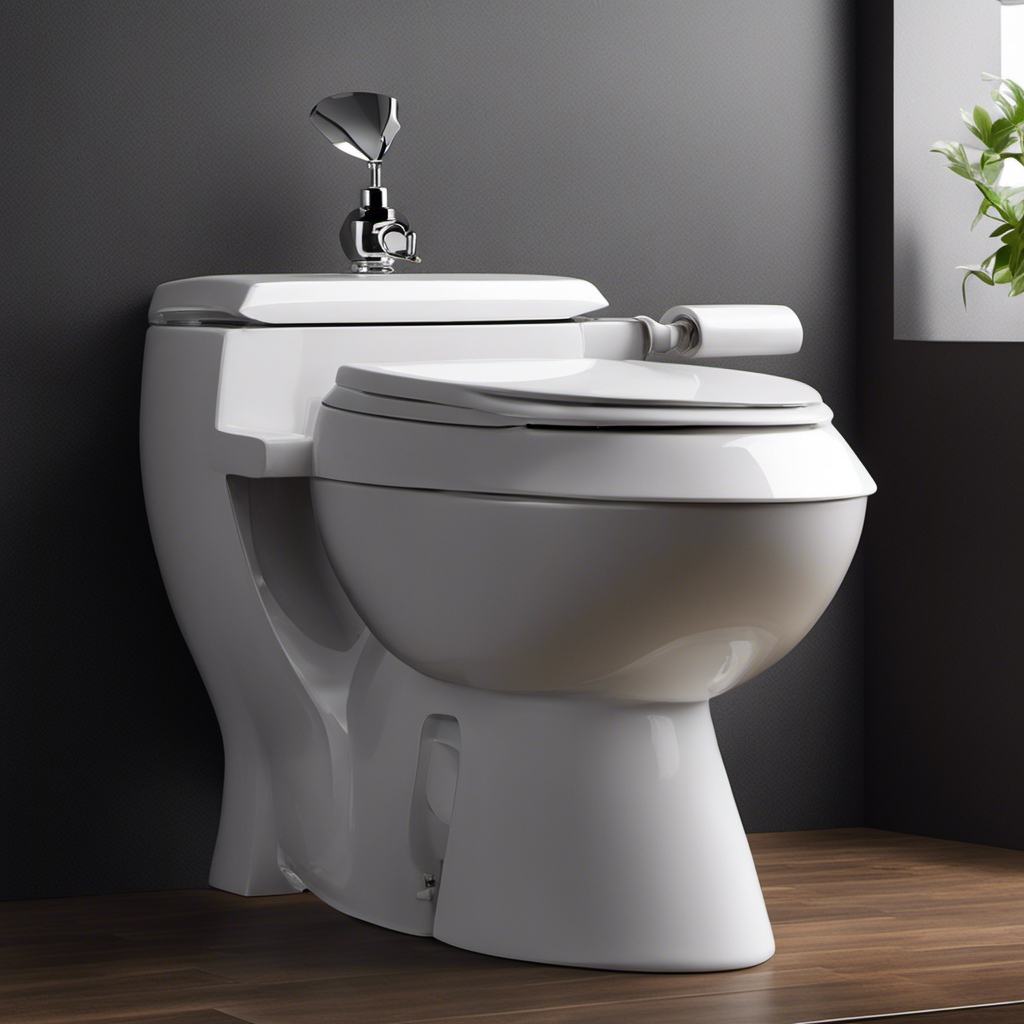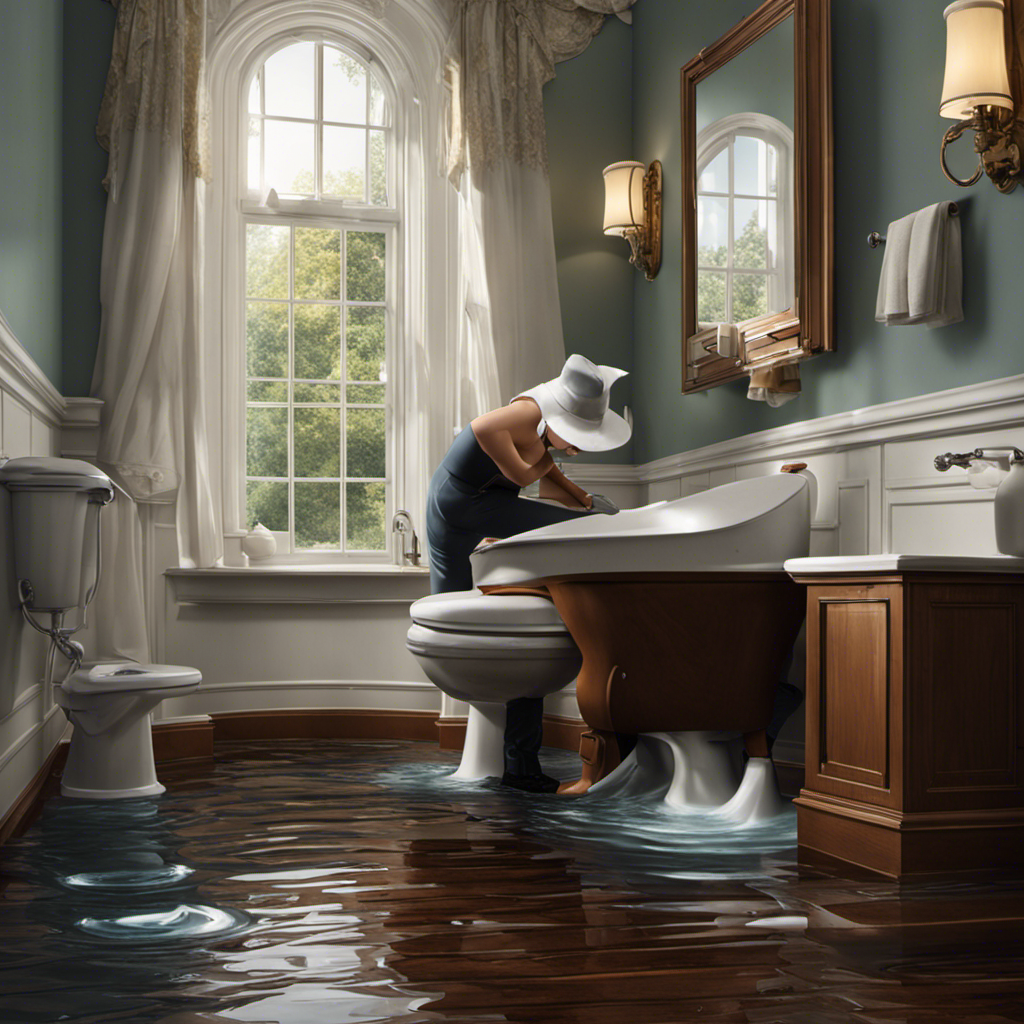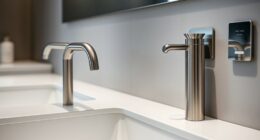As they say, ‘You are what you eat.’
But have you ever considered what you’re exposed to every time you flush?
In this article, I’ll delve into the murky depths of toilet water and uncover the truth about its cleanliness.
From bacteria and germs to common contaminants, we’ll explore the potential health risks and factors that affect the quality of this seemingly innocuous liquid.
So, buckle up and prepare to be informed about just how dirty toilet water can be.
Key Takeaways
- Toilet water in public restrooms has a high concentration of bacteria and germs, making it particularly susceptible to contamination.
- Toilet water can contain harmful contaminants such as E. coli and Staphylococcus, which can cause infections and illnesses.
- Proper toilet water treatment and adherence to quality standards are essential to ensure the cleanliness and safety of the water.
- Practicing good hygiene, such as washing hands thoroughly and properly cleaning toilet bowls with disinfectant, can help minimize exposure to dirty toilet water.
Bacteria and Germs Found in Toilet Water
There’s a high concentration of bacteria and germs in toilet water. Public restrooms, where multiple people use the same toilet, are particularly susceptible to bacterial contamination. The constant flow of users increases the chances of different strains of bacteria and germs being introduced into the water.
Additionally, cleaning products used in public restrooms can have an impact on the quality of toilet water. While these products are designed to kill bacteria and germs, they can also introduce chemicals and residues that may further contaminate the water.
It’s important to note that not all bacteria found in toilet water are harmful. However, some common contaminants in toilet water, such as E. coli and Staphylococcus, can cause infections and illnesses. These contaminants will be discussed further in the subsequent section.
Common Contaminants in Toilet Water
You’ll be surprised by the various contaminants commonly found in toilet water. It’s not just bacteria and germs that lurk in there. Here are three other substances that may shock you:
-
Chemicals: Toilet water can contain traces of chemicals like chlorine, which is used in water treatment plants to kill harmful bacteria. However, high levels of chlorine can be harmful to human health.
-
Pharmaceuticals: Many people flush expired or unwanted medications down the toilet, leading to the presence of pharmaceuticals in toilet water. These drugs can have adverse effects on the environment and even end up in our drinking water sources.
-
Microplastics: Studies have shown that microplastics, tiny particles of plastic less than 5mm in size, are present in toilet water. These microplastics come from sources like synthetic clothing fibers and personal care products.
To ensure the safety of toilet water, proper toilet water treatment and adherence to toilet water quality standards are essential. It’s crucial to be mindful of what we flush down the toilet to protect our health and the environment.
Health Risks Associated With Toilet Water
Flushing certain substances can pose health risks due to the presence of contaminants in toilet water. It’s important to be aware of the potential consequences and not dispose of various items down the toilet. One health risk associated with toilet water is skin irritation. The presence of chemicals, bacteria, and other pollutants in the water can cause irritation and rashes on the skin.
Additionally, toilet water can also harbor waterborne diseases. If the water is contaminated with pathogens such as bacteria or viruses, flushing can spread these microorganisms and potentially lead to infections or illnesses.
To minimize these health risks, it is recommended to only flush toilet paper and waste, and to properly dispose of other items in their designated ways.
Factors Affecting the Cleanliness of Toilet Water
To maintain the cleanliness of the water, it’s important to consider factors such as the quality of the pipes and the effectiveness of the water treatment process. These factors play a crucial role in ensuring that toilet water is safe for use. Here are three key considerations:
-
Toilet Water Filtration: Proper filtration systems are essential for removing impurities and contaminants from toilet water. This process helps to eliminate harmful bacteria and viruses, ensuring that the water is safe for use.
-
Impact of Cleaning Products: The cleaning products we use in toilets can have an impact on the cleanliness of the water. Harsh chemicals and antibacterial agents may kill harmful bacteria but can also leave behind residues that can contaminate the water supply.
-
Regular Maintenance: Regular maintenance of toilet pipes and fixtures is crucial for preventing leaks and minimizing the risk of bacterial growth. Proper maintenance can help to maintain the overall cleanliness and quality of the water.
Tips for Minimizing Exposure to Dirty Toilet Water
When it comes to minimizing exposure to unclean toilet water, one effective tip is to always wash your hands thoroughly after using the restroom. Toilet water can be contaminated with various bacteria and viruses, including E. coli, Salmonella, and norovirus. These pathogens can cause severe illnesses, such as gastrointestinal infections.
Another important tip is to ensure proper cleaning of toilet bowls. Regularly cleaning the toilet bowl with a disinfectant can help reduce the risk of contamination. It is also crucial to flush the toilet with the lid closed to prevent the spread of germs in the air.
Frequently Asked Questions
How Often Should I Clean My Toilet to Minimize the Presence of Bacteria and Germs in the Water?
To minimize bacteria and germs in toilet water, I clean my toilet regularly. It’s crucial for toilet water quality and to prevent contamination. Following a cleaning schedule helps maintain a hygienic environment.
Can Flushing the Toilet With the Lid Open Spread More Bacteria and Germs Into the Air?
Flushing the toilet with the lid open can spread bacteria and germs into the air. It’s important to close the lid before flushing to minimize the risk of contamination. Additionally, toilet water can be recycled for agricultural purposes and used as a source of alternative energy.
Are There Any Specific Chemicals or Disinfectants That Are Effective in Killing Bacteria and Germs in Toilet Water?
Chemical alternatives and natural remedies can effectively kill bacteria and germs in toilet water. By using disinfectants specifically designed for toilets, you can ensure a clean and hygienic environment.
Can Using Toilet Seat Covers Provide an Effective Barrier Against the Transfer of Bacteria and Germs From Toilet Water?
Toilet seat covers are often used as a barrier against bacteria transfer, but their effectiveness may vary. Cleanliness of toilet water in public restrooms can be compromised, making seat covers a potential precautionary measure.
Are There Any Measures I Can Take to Ensure the Cleanliness of Toilet Water in Public Restrooms?
In public restrooms, it’s crucial to prioritize hygiene. One effective measure is practicing proper handwashing. This helps reduce the risk of contamination from toilet water and prevents the spread of harmful bacteria and germs.
Conclusion
In conclusion, toilet water may seem like a breeding ground for germs and bacteria, but the truth is not as alarming as it appears. While there are certainly contaminants present, the risk of contracting a serious illness from toilet water is relatively low.
By practicing good hygiene, such as washing hands thoroughly after using the bathroom, we can minimize exposure to any potential pathogens. So, don’t let the fear of dirty toilet water flush away your peace of mind!
Stay informed, stay clean, and stay healthy.










